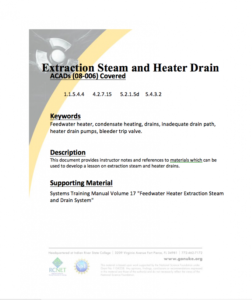RCNET ACAD 08-006 Crosswalk: 1.1.5 Core Curriculum - Heat Transfer and Fluid Flow

Program Description:
This material was published by the Regional Center for Nuclear Education and Training (RCNET) as part of a comprehensive crosswalk that links objectives of ACAD 08-006 with GP Strategies ABC Material, NUCP Surveyed Material, NANTeL resources, EPRI resources, web resources, and published material available to all RCNET partners. These accredited utility training programs are based of training and qualification guidelines (ACADs) published by the National Academy for Nuclear Training.
ACAD 08-006 is the Uniform Curriculum Guide for Nuclear Power Plant Technician, Maintenance, and Nonlicensed Operations Personnel Associate Degree Programs and includes five main curriculum areas: Core Curriculum, Discipline-Specific Curriculum for Nonlicensed Operators, Discipline-Specific Curriculum for Radiological Protection Technicians, Discipline-Specific for Chemistry Technicians, and Discipline Specific for Maintenance Personnel.
Contents:
The Core Curriculum is divided into three sections: Fundamentals, Basic Systems Knowledge, and Basic Components Knowledge. This Heat and Transfer Fluid Flow section of Fundamentals (ACAD 08-006 1.1.5) covers the principles and concepts related to heat, steam, heat transfer, and fluid flow.
Documents associated with ACAD 08-006 1.1.5 include one PowerPoint presentation and one lesson plan document with instructor notes.
This material covers, more specifically: heat transfer mechanisms and heat exchanger construction and types; temperature including temperature scales, F, C, and K; basic steam-water cycle, boiling and saturation; properties of steam and water including pressure-temperature relationship, basic steam-water cycle, steam tables, boiling, saturation, temperature/pressure and thermal efficiency; steam tables; heat transfer mechanisms such as conduction, convection, and radiation; heat exchangers; latent and sensible heat; thermal efficiency; effects of throttling on flow and pressure; filling and venting understanding the concept of high point vents relating to air binding and water hammer; fluid properties and mechanics including laminar and turbulent flow; flow within a closed system to include water hammer, heating, draining, filling and venting, and the effects of throttling, pump theory including cavitation; and water hammer types and mechanisms.
About this Resource


Comments